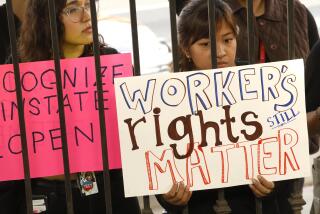Art provenance research still ‘far behind’
- Share via
A national survey of art museums to determine the state of research on possible Nazi loot has concluded that the job is far from done.
Seven years after the American Assn. of Museums established guidelines for dealing with artworks created before 1946 and acquired by the museums after 1932 -- and which changed hands in Europe when the Nazis were confiscating art -- many museums have accepted the responsibility of reviewing their collections. Some have made serious efforts to pinpoint possible problems, but “others have lagged far behind,” states a summary of the survey, conducted by the New York-based Claims Conference and posted on its website, www.claimscon.org/ Tuesday.
The survey found 140,000 objects that “need provenance research,” far more than the 18,000 objects posted on the Nazi-Era Provenance Internet Portal maintained by the museum association. Most of the museums actively conducting provenance research have completed work on less than half the relevant items in their collections, only about 33% of the museums have a separate budget for the purpose and only about 10% have employed a full-time researcher, the survey says.
In the Los Angeles area, the Los Angeles County Museum of Art, the Huntington Library, Art Collections and Botanical Gardens and the USC Fisher Gallery participated in the survey. Accounting for their progress and processes of collection review, they reported 80,200 objects that fit into the time frame under investigation.
The report indicates that although the objects need to be examined, not nearly all are likely be suspect.
The survey project “wasn’t driven by a sense of a problem,” said Gideon Taylor, executive vice president of the Claims Conference, which has worked on Holocaust victims’ compensation and restitution issues for 50 years. “We felt that it was important to take stock of how far we’ve got and what we still need to do to finish this task.” Time is of the essence for Holocaust survivors and their heirs, he said.
But Edward H. Able Jr., president and chief executive of the museum association, said that the survey “overstates the issues and underestimates the efforts of the American museum community to assure the public and themselves that there are no looted Holocaust assets in our museums. This has been an ongoing commitment from the museum community for some years now and, even with limited resources, we have accomplished a great deal.” Many museums cannot afford to employ a full-time researcher and few qualified people are available, he said.
“We share the goal of the Claims Conference, and we are committed to doing it,” Able said. But he questioned estimates of the number of objects that might be suspect. Sometimes a great deal of research is required to find out if the possibility of a problem exists. “I think the bulk of objects with identifiable problems are on the Internet portal,” he said.
Taylor said that his only disappointment was that 118 of the 332 museums asked to complete the survey failed to meet the deadline. Among them was the J. Paul Getty Museum.
Getty spokesman John Giurini said the museum was completing the survey and planned to submit it this week. However, the museum, which has done extensive provenance research for many years, has submitted 447 items to the museum association’s portal.
Among museums that met the deadline, LACMA reported that it had dropped its full-time researcher in late 2004 because of a lack of funds but that staff members continue the work. LACMA has about 50,000 objects created before 1946 and acquired after 1932, the time being reviewed. The museum has posted six paintings with gaps in provenance on the museum association’s Internet portal (www.nepip.org). The Fisher Gallery has 200 objects under review, 106 of which are posted. The Huntington has about 30,000 objects in the same time frame, two of which are posted.
Next, Taylor said, is a hearing Aug. 3 in the House of Representatives’ Financial Services Committee, which is expected to address the completion of the museum project and approach the possible formation of guidelines for the private sector.
More to Read
The biggest entertainment stories
Get our big stories about Hollywood, film, television, music, arts, culture and more right in your inbox as soon as they publish.
You may occasionally receive promotional content from the Los Angeles Times.










